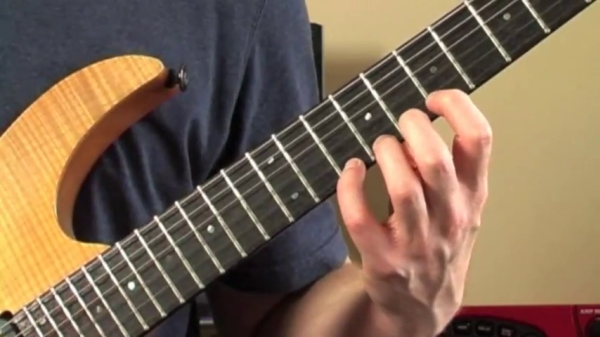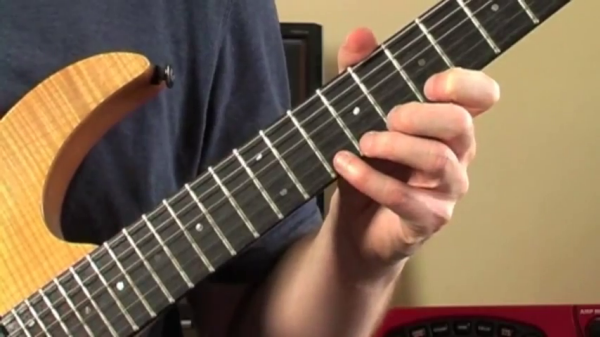Introduction
In this lesson we’re going to take a look at the two main hand positions that are used for rock guitar playing. They are both very important to understand and master. This is because each one of them will make certain aspects of guitar playing easier, and mastering both will make you a much more versatile guitarist.
Let’s now take a look at the first one…
The Classical Hand Position
This hand position is the one that is most commonly described as being the “correct” one by some guitar teachers. While I don’t agree in such black-and-white thinking, the classical hand position is essential to master if you want to play guitar at a high level. Here’s a photo of what it looks like…

In the photo above I am demonstrating what the classical hand position looks like with all my fingers pressing down on the thin E-string. The key things to notice from the photo are…
- My thumb is at the back of the neck and is opposite my second finger.
- The biggest finger joints, the ones that are closest to my hand, are all roughly the same distance from the guitar neck.
- All my fingers are evenly-spaced and curved.
- My first finger is leaning slightly towards the headstock end of the guitar neck.
- My fourth finger is leaning slightly towards the body end of the guitar neck.
- My second and third fingers are more upright.
- No part of the fingers are touching the underside of the guitar neck.
The classical hand position is a fantastic one to use anytime…
- You want to keep all your fingers separated.
- You need to do wide stretches.
- You need to use your little finger on the lower-sounding strings.
- You need to play barre chords.
Now that we’ve touched on the first hand position, let’s now take a look at the second one…
The Rock Hand Position
This hand position looks very different than the previous one, and is the one that you see rock guitarists use most often when playing lead guitar. Here’s a photo of what it looks like…

To make the comparison between the two hand positions clearer, I have demonstrated the rock hand position in the same fretboard location as shown in the first photo. Here are a few things that you might notice by looking at the photo above…
- My thumb is resting on the top of guitar neck.
- All the fingers are angled rather than being perpendicular to the guitar neck.
- Although it’s not really visible in this photo, the part of the first finger that is closest to is the largest finger joint is resting against the underside of the guitar neck.
The rock hand positions is most useful when you want to…
- Bend strings.
- Do vibrato.
It’s Not So Cut-And-Dried
It’s really important to realize that what hand position you choose to use at any specific point in time will depend on factors such as…
- Your physical attributes such as hand size and finger length.
- What you have played just before that point in time.
- What you’re about to play just after that point in time.
Many high-level electric guitarists will switch many times, in a very fluid way, between the two hand positions while they are soloing.
It’s also important to mention here that the two hand positions I’ve mentioned are extremes. It’s not uncommon for players to sometimes use a hybrid between the two approaches. For Example: Quite often I will place my thumb in a position that is somewhere between where it is when I’m using a rock hand position, and where it is when I’m using a classical hand position.
A Few Last Words
As you learn new things on the guitar, I recommend consciously choosing what hand position you use. The best way to do this is to play what you’re learning with both hand positions, and then choosing the hand position that feels most comfortable for what you want to play. If you continue doing this with everything that you learn, you’ll find that you’ll gain the experience that will allow you to automatically choose the best hand position for what you want to play.
Return To: Guitar Technique Lessons